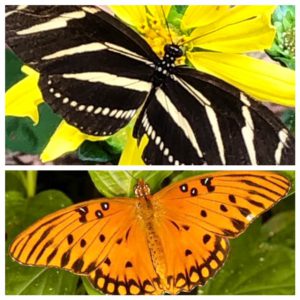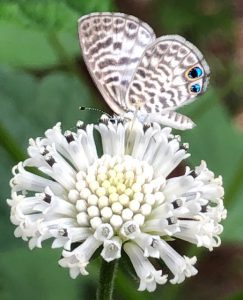
When it comes to butterfly gardening, monarch butterflies seem to get all the love. Monarchs are the butterfly “homecoming queens”! They are drama queens, too, as they lead fascinating lives of intrigue, participating each year in a miraculous-seeming migration across North and Central America. In recent years numerous studies have shown a horrific decline in monarch populations. It is no wonder that conservation-minded gardeners everywhere want to support this large and beautiful butterfly.
As homecoming queens have their court, monarchs too can share the “glory”. Did you know there are other equally beautiful and fascinating butterfly species whose populations have also declined? Many of these butterflies are quite common in central Florida.
Following are just a few wonderful butterfly species that you can easily attract to your garden, along with some of their host plants. These host plants are usually not too difficult to locate commercially, and all of them are easy to grow. Always purchase native host plants from trusted sources. (Go to here to locate native plant nurseries in our area.)
Zebra Longwing

This striking medium-sized butterfly is Florida’s official state butterfly. They are found much of the year in our area and can be seen darting in and out of shady spots in the yard. Easily identified, they are black with bright yellow stripes. Host plants are native passionvines, including Passiflora incarnata or Passiflora suberosa. Plant these vines in shade or semi-shade to support Zebra Longwings.
Gulf Fritillary
This bright orange medium-sized butterfly lends cheerful garden color during much of the year. Host plants are also native passionvines. Gulf Fritillaries prefer sunny open areas, plant passionvines in a sunny spot.
Cloudless, Orange-Barred, and Sleepy Orange Sulfur butterflies
Plant native senna shrubs such as Senna mexicana var.chamanii or Senna ligustrina, and enjoy not one but three colorful (bright yellow or orange) butterflies. These butterflies are seen much of the year in our area, more frequently in the spring and fall.
Black Swallowtail
This large and beautiful butterfly is easily attracted to your edible garden, as their host plants include common herbs in the carrot family. Plant parsley, dill, or fennel and if you grow them for culinary use, plant multiple plants so you can share your herbs with your caterpillars!
Pipevine Swallowtail, Polydamas Swallowtail
These beautiful large swallowtails can be found in our area mainly during spring through fall. Host plants are native species of pipevine, (Aristolochia spp). Purchase native pipevine species from trusted sources to avoid using exotic pipevine species, as they are toxic to the larvae of these butterflies.
White Peacock, Common Buckeye, and Phaon Crescent

If you plant areas of your garden with the groundcover frogfruit (Phyla nodiflora), you will provide a host plant for these three diverse and colorful butterflies.
Cassius Blue
Mother Nature often surprises us with gifts of incredible beauty in small packages! This tiny greyish/white butterfly is adorned with a spot so iridescent in color it appears as a jewel! Host plants include plumbago (the native Plumbago zeylanica, as well as the non-native P. auriculata).
Many sources offer guidelines on how to design, plant and maintain butterfly gardens. A few general tips to highlight:
* Try to supply enough foliage to feed your caterpillars. If you are just beginning, it is better to have multiple host plants of one species, rather than one each of differing species.
* Think of your whole yard as a butterfly garden! Locating host plants in different areas of your property will help decrease predators who learn quickly where there is a concentration of yummy caterpillars. Separating host plants also decreases territorial conflicts of butterfly species trying to dominate one area.
* Even butterflies who are listed to be in our area “all year” may have periods where they are more visible than others. Spring and fall seem to be the most active. In the summer they may leave to fly elsewhere; during cold weather they tend to move south.
* Remember to include nectar plants in your garden. Providing a diversity of host and nectar plants will encourage returning generations of butterflies, as well as other native pollinators!
* Always avoid the use of pesticides around your butterfly plants. When planning your garden, be aware of areas that pesticide over-spray from neighbors can reach and harm your butterflies (and all pollinators).
By planting host plants for a diversity of butterfly species, we can help protect the populations of not just monarchs but other beautiful and important species. Happy Gardening!
References
For general information, Butterfly Gardening in Florida
For information on specific butterflies (and other insects):
Featured Creatures
For information on native plants
For a listing of native plant nurseries in Florida
This article was written by Master Gardener Volunteer Molly Griner under supervision of the Master Gardener Volunteer Coordinator and Residential Horticulture Agent Anne Yasalonis.
For more information, contact UF/IFAS Extension Polk County at (863) 519-1041 or visit us online at http://sfyl.ifas.ufl.edu/polk. The Plant Clinic is open Monday-Friday, 9:00 am-4:00 pm to answer your gardening and landscaping questions. Give us a call, or email us at polkmg@ifas.ufl.edu.
If you are not in Polk County, Contact your local UF/IFAS Extension Master Gardener Volunteer Plant Clinic.
The Florida Master Gardener Volunteer Program is a volunteer-driven program that benefits UF/IFAS Extension and the citizens of Florida. The program extends the vision of the University of Florida/Institute of Food and Agricultural Sciences, all the while protecting and sustaining natural resources and environmental systems, enhancing the development of human resources, and improving the quality of human life through the development of knowledge in agricultural, human and natural resources and making that knowledge accessible.
An Equal Opportunity Institution.
 0
0
